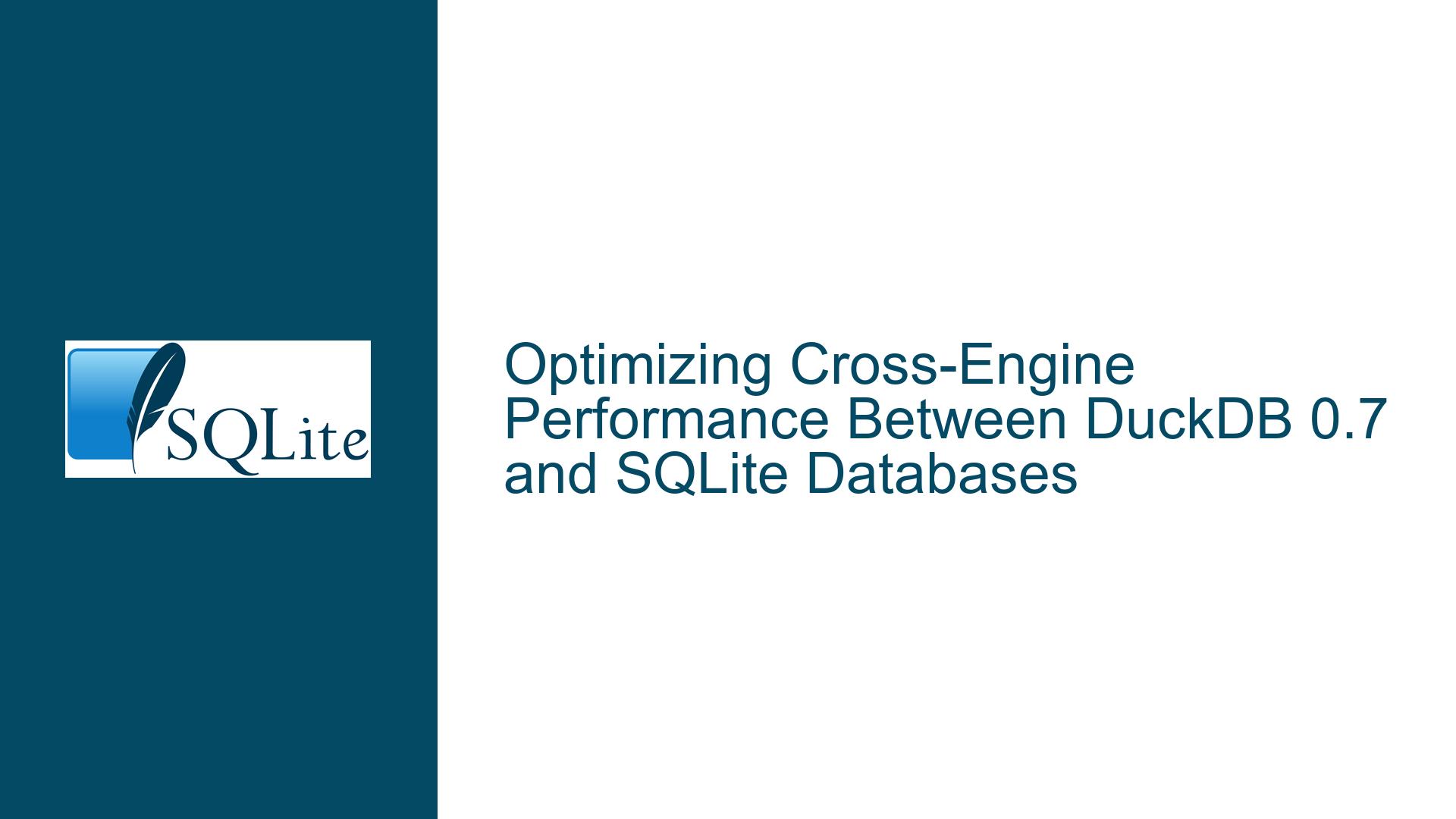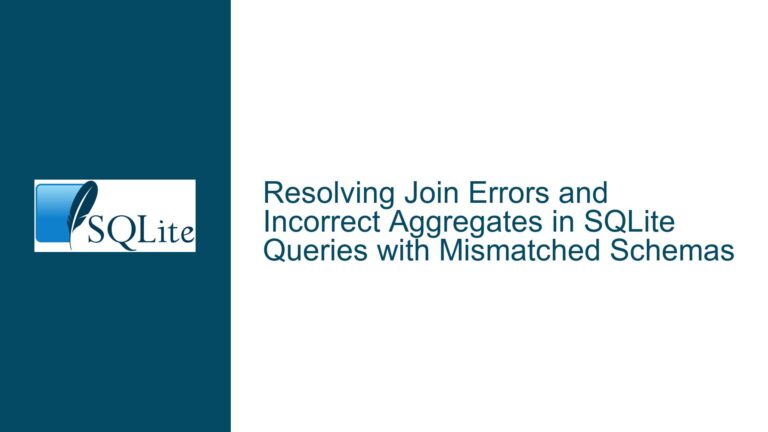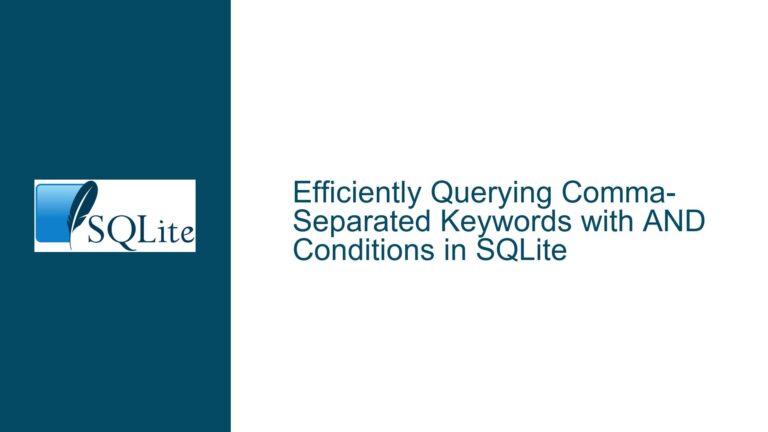Optimizing Cross-Engine Performance Between DuckDB 0.7 and SQLite Databases
Understanding DuckDB 0.7’s SQLite Database Integration
The integration of DuckDB 0.7 with SQLite databases introduces a novel hybrid architecture where DuckDB acts as a front-end query engine for SQLite database files. This capability allows users to attach SQLite databases to DuckDB sessions and execute analytical queries using DuckDB’s execution engine while reading/writing data stored in SQLite’s file format. The core innovation lies in DuckDB’s pluggable storage engine API, which bypasses SQLite’s query planner (NGQP) and directly accesses SQLite’s B-tree structures, indexes, and page layouts. However, this setup creates a layered dependency: DuckDB parses queries, generates execution plans, and delegates I/O operations to SQLite’s storage layer.
This architecture raises critical questions about performance parity, especially for analytical workloads. While DuckDB’s vectorized execution model and parallel query processing are optimized for OLAP scenarios, SQLite’s row-oriented storage format and single-threaded design inherently prioritize transactional consistency over bulk data scans. The physical data layout (page sizes, index organization, and WAL configurations) in SQLite databases may impose structural constraints on DuckDB’s ability to leverage its performance advantages. For example, DuckDB’s columnar scanning optimizations might be nullified if forced to process row-wise data from SQLite tables.
Additionally, metadata translation between the two systems introduces overhead. DuckDB must map SQLite’s type affinities (e.g., INTEGER, TEXT, BLOB) to its own type system (e.g., INT64, VARCHAR, BLOB) during query execution. While DuckDB’s SQLite extension handles this transparently, type coercion and collation differences can lead to unexpected behavior in edge cases, such as date/time formatting or locale-specific string comparisons.
Identifying Performance Bottlenecks in Cross-Engine Query Execution
Performance degradation in DuckDB-to-SQLite workflows can stem from three primary sources: storage engine mismatches, query planner limitations, and concurrency model conflicts.
Storage Engine Mismatches:
SQLite’s page-based storage allocates fixed-size blocks (default 4KB) for tables and indexes. DuckDB’s execution engine, designed for columnar data access, may struggle to efficiently decode row-oriented pages during sequential scans. For analytical queries requiring full-table scans (e.g.,SELECT SUM(revenue) FROM sales), DuckDB must deserialize entire rows from SQLite’s pages even if only a subset of columns are referenced. This forces unnecessary data movement and increases CPU cache pressure compared to DuckDB’s native Parquet or.duckdbfile formats, which support columnar projection pushdown.Query Planner Limitations:
DuckDB’s query planner cannot fully optimize execution plans when operating on SQLite-attached databases. For instance, SQLite’s lack of statistics storage (e.g., histograms or correlation data) prevents DuckDB from making informed decisions about join ordering or index selection. DuckDB’s cost-based optimizer relies on table-level metadata that SQLite does not expose, leading to suboptimal plans for complex queries involving multiple joins or aggregations.Concurrency Model Conflicts:
SQLite’s write-ahead logging (WAL) mode allows concurrent readers and a single writer, but DuckDB’s parallelism may inadvertently trigger lock contention. When DuckDB spawns multiple threads to scan a SQLite table, each thread opens a separate reader connection. If the SQLite database is in WAL mode, this is permissible, but write operations from DuckDB (e.g.,UPDATE,INSERT) will still block all other writers and readers during checkpointing. This negates DuckDB’s ability to perform concurrent writes, a capability it natively supports with its own storage format.
Benchmarking Analytical Queries Between DuckDB and SQLite’s NGQP
To diagnose performance issues and validate optimizations, adopt a structured benchmarking approach:
Step 1: Isolate Query Execution Components
Run identical analytical queries (e.g., multi-table joins, window functions, aggregations) in three configurations:
- Native SQLite: Uses SQLite’s NGQP and execution engine.
- DuckDB with SQLite Attached: DuckDB parses/plans/executes the query against a SQLite file.
- DuckDB Native: Query executed on the same data imported into DuckDB’s native format.
Measure wall-clock time, memory usage, and I/O operations for each configuration. Use tools like EXPLAIN ANALYZE in DuckDB and sqlite3_profile hooks to capture planner outputs and execution statistics.
Step 2: Analyze Data Layout Impact
Convert a SQLite database to DuckDB’s native format using EXPORT DATABASE and re-run benchmarks. If performance gaps narrow significantly, the bottleneck is likely SQLite’s row-oriented storage. To confirm, inspect low-level I/O patterns using PRAGMA sqlite3_page_count (SQLite) and DuckDB’s PRAGMA storage_info extension. High page read counts in DuckDB-SQLite mode indicate inefficient data access.
Step 3: Optimize Hybrid Workflows
For workloads requiring frequent cross-engine access, consider these mitigations:
- Materialize Hot Data: Use
CREATE TABLE AS SELECTin DuckDB to snapshot frequently queried SQLite tables into DuckDB’s native format. - Index Smartly: Add covering indexes in SQLite for columns used in DuckDB’s WHERE clauses or JOIN conditions. Since DuckDB cannot create native indexes on SQLite tables, pre-indexing in SQLite reduces scan overhead.
- Batch Writes: Aggregate write operations in DuckDB and flush them to SQLite in transactions to minimize lock contention.
Step 4: Tune DuckDB’s SQLite Extension
Adjust DuckDB’s connection parameters when attaching SQLite databases. For example, increasing sqlite_threads=4 allows parallel page reads, but only if the underlying filesystem supports concurrent access. Set sqlite_cache_size=-131072 to configure a 512MB page cache within DuckDB’s process space, reducing filesystem I/O.
Step 5: Monitor Concurrency Limits
Use SQLite’s sqlite3_status(SQLITE_STATUS_OPEN_READERS) to track active connections from DuckDB threads. If reader counts exceed SQLite’s max_page_count, consider throttling DuckDB’s parallelism via SET threads TO 2;. For write-heavy workloads, isolate write operations to a dedicated DuckDB connection to avoid starvation.
Final Fixes:
If benchmarks reveal persistent bottlenecks, transition to DuckDB-native storage for analytical workloads while using SQLite as a transactional front-end. Implement an ETL pipeline (e.g., via DuckDB’s COPY FROM command) to periodically sync data from SQLite to DuckDB. For real-time queries, use DuckDB’s ability to attach both engines simultaneously, routing reads to the optimal storage backend based on query type.
This guide provides a comprehensive framework for diagnosing and resolving performance issues arising from DuckDB’s integration with SQLite databases, emphasizing empirical validation and targeted optimizations.






